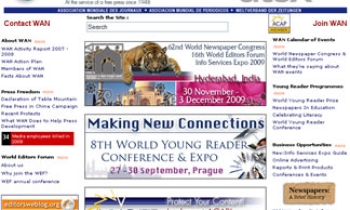About 70 reporters, editors, photographers and newsroom administrators have taken early retirement offers from The Washington Post Co., as the company's flagship newspaper works to contain costs while circulation continues a slow slide.
Some familiar and veteran bylines will exit The Post's pages, such as those of political writer Thomas B. Edsall, science writer Guy Gugliotta, foreign correspondent Daniel Williams, Metro reporter (and panda chronicler) D'Vera Cohn, and business columnists Jerry Knight and Leslie Walker.
Staffers age 54 and older with 10 years of service were eligible to receive up to two years of full-time pay and benefits in exchange for leaving the newspaper before retirement age. Some, such as television critic Tom Shales and Metro columnist Courtland Milloy, are taking the offer but will keep writing for a period under contract. Others will become Post freelancers.
The deadline for taking the early retirement offer, known colloquially in the industry as a "buyout," was Tuesday, but those who took it have a week to change their minds, so the final number of employees taking it is not set. Many have left The Post or will exit this week; others will stay on for a few months. About 100 Post employees outside the newsroom, such as those in the newspaper's pressrooms or on the advertising staff, took the offer.
"This offering allows the news and business departments to reorganize their staffs in ways that work well today," said Post publisher Boisfeuillet Jones Jr. Buyouts are a common tool for businesses seeking to cut payroll costs. They generally are offered to older, higher-salaried employees. Their positions either remain unfilled or are filled by younger employees at lower salaries.
For many Post staffers, the buyouts offer a chance to start second careers at a youthful age or pursue hobbies while receiving a steady pension check. Walker, the Business section's technology columnist, for instance, will work to finish a novel she started last year. Gugliotta's wife, Carla Anne Robbins, recently accepted a job writing editorials for the New York Times. They will move to the New York City region, and he will freelance. Horse aficionado Alison Howard, a Metro editor, will start an equestrian-services business with friends.
Circulation at The Post and most daily newspapers has decreased in recent years, as readers turn to television and the Internet for news and information that once was the province of newspapers. The most recent year the average circulation for U.S. newspapers grew was 1987. Since then, it has been all downhill.
Daily circulation at The Post peaked at 832,232 in 1993. The Post's daily circulation for the first three months of this year averaged 690,700, the company reported last month.
Newspapers get about 75 percent of their revenue from advertising, and ad rates rise and fall with circulation figures. Ad revenue from The Post's Web site is increasing, but not fast enough to offset revenue loss from declining newspaper circulation.
"Our newsroom has grown a lot over a number of years, in both size of staff and other expenses," said Post executive editor Leonard Downie Jr. "And as circulation has declined some and advertising revenue has leveled off at the moment, and we continue to have to pay higher costs for travel and those sorts of things and continue to give raises to members of our staff, we had to find some way to reduce the overall size of the newsroom."
The 2006 newsroom budget was about the same as last year's, Downie said, and will shrink next year. Post Co. executives asked the newsroom to cut expenses but never threatened to take control of the news budget, Downie said. Top newsroom editors decided to cut what they called 80 "full-time equivalent" positions -- hoping to achieve the number through buyouts, trimming part-time employee hours and keeping some positions on the staff of more than 800 unfilled.
At least 69 newsroom staffers have accepted the buyouts; Downie said there are no plans for layoffs. "We're going to be all right," he said.
As The Post and other newspapers attempt to follow their readers into other media, staffers are asked to do more. The Washington-Baltimore Newspaper Guild, which represents many newsroom employees, has filed a complaint with the National Labor Relations Board because The Post will not negotiate with the union to set terms and conditions for paying reporters and editors asked to appear on Washington Post Radio, which the newspaper launched in March.
"It's up to people to decide to tell us if we are overworking them," Downie said.
Several other newspapers are using buyouts to cut costs; some are resorting to layoffs.
The New York Times Co. is cutting 700 company-wide jobs. About 130 of those came from the Times-owned Boston Globe, which offered buyouts. Tribune Co., which publishes 11 newspapers including the Los Angeles Times, said last week that it would use layoffs to cut costs. Last year, Tribune newspapers eliminated 185 positions through buyouts and layoffs. In 2005, the St. Louis Post-Dispatch cut 12 percent of its newsroom staff and the Philadelphia Inquirer 15 percent.
This is The Post's second round of buyouts in the past three years. As they were last time, the buyouts are funded by The Washington Post Co. pension fund.
In 2003, 54 staff members age 55 and older took the offer, but many were offered contracts to work part of the year without benefits. The age was lowered to 54 this time, and fewer contracts were offered.
Among The Post's daily sections, the Photo and Business staffs are losing the most staffers, proportionally. The weekly Food section is losing four of six full-time staffers.
Many of the positions will be filled.
Seven photographers and two photo editors -- 25 percent of the staff -- are taking the buyouts, including Lucian Perkins, who won the Pulitzer Prize in 1995 and 2000.
Nine Business reporters, editors and columnists from a full- and part-time staff of 71 are taking the buyouts. Familiar names to readers include international economics reporter Paul Blustein, who plans to write books; tax specialist Albert B. Crenshaw; and consumer reporter and blogger Caroline E. Mayer.
"It's very hard and sad to leave a newsroom after 25 years," said Mayer, who has already booked a vacation. "But it's also very exciting to ponder all the opportunities that a second career could offer. Besides, there's the hope of lots more free time. Who could beat that?"









